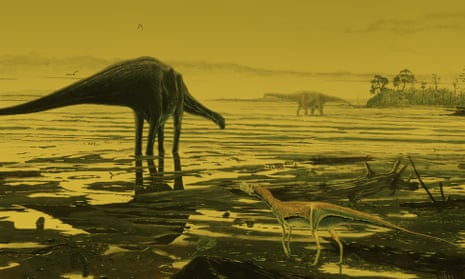Ancient tracks from sauropods that plodded through a lagoon in the middle Jurassic period have been uncovered on the Isle of Skye, making the spot the largest dinosaur site in Scotland.
The zigzag pattern of giant prints was spotted on a slab of rock reaching out to sea on the north eastern tip of the island by researchers from Edinburgh University.
Left by multiple beasts over thousands of years, the tracks number in their hundreds.
“It’s a cool thing for Scotland to have such a big dinosaur site and it’s important globally, because these are from a time in the middle of the Jurassic where there are hardly any fossils anywhere else,” said Steve Brusatte, a palaeontologist who led the expedition.

The 170-million-year-old prints are in several layers of rocks that formed from sediments at the bottom of a brackish lagoon, when the sea was farther away and more cut off from the land than it is today. The tracks are detailed enough for researchers to identify them as the work of primitive sauropods, most likely distant relatives of brontosaurus and diplodocus.
“We can start to think about what these dinosaurs were like as living animals and it’s a weird thing, maybe, to think of them wading around in a lagoon,” said Brusatte. “These dinosaurs would have been walking in some water, not really deep water, but maybe knee deep or a little less.”
The fossil hunters noticed the tracks one day in April as the tide turned and the sun went down on the edge of the island where the remains of Duntulm castle stand in the distance. As the tide came in, the researchers saw pits in a huge slab of rock about 30m long that is submerged at high tide and covered with seaweed at some times of year.
“My colleague Tom Challands and I were walking back to the vehicles when we noticed this big depression in the rock, like a pothole half a metre wide. We looked at each other, and then saw another and another in a zigzag pattern,” Brusatte said. “Both of us had seen similar things before in other parts of the world and we knew they were dinosaur footprints.”
The tracks were preserved when sediments, perhaps stirred up by storms, washed into the footprints left in the lagoon bed after the animals had passed. Some are now visible as dents the size of dustbin lids, others as casts, created when the stone around them weathered away. Details are published in the Scottish Journal of Geology.
“There are probably thousands of tracks if you could trace the layer of rock underground and out into the water. There are tracks everywhere. This wasn’t just some lonesome dino walking through this lagoon,” said Brusatte. “My guess is the layers span at least thousands of years.”
The number of toes, their shapes, and heel pads at the back of the foot, all mark the prints out as belonging to primitive sauropods that grew to at least 15 long and weighed more than 10 tonnes.
The trails were found during fieldwork with Skye’s Staffin Museum and the National Museums of Scotland in Edinburgh.
Challands said the discovery established the Isle of Skye as an area of major importance for research into the mid-Jurassic period. “It is exhilarating to make such a discovery and being able to study it in detail, but the best thing is this is only the tip of the iceberg.”

Comments (…)
Sign in or create your Guardian account to join the discussion